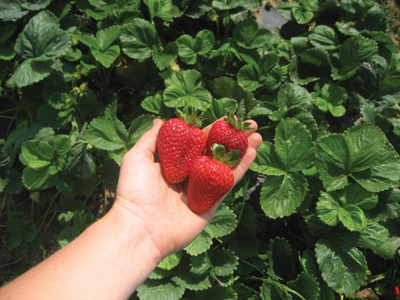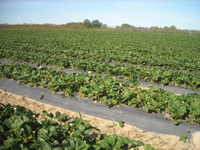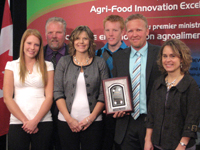
Features
Fruit
Production
Tigchelaar Berry Farms: Married to day-neutral strawberries
May 3, 2010 By James Careless
Dan and Jeff Tigchelaar are brothers and second-generation farmers.
They have three farms in the Niagara region and one in Binbrook (the
homestead), near Hamilton, Ontario.
Dan and Jeff Tigchelaar are brothers and second-generation farmers. They have three farms in the Niagara region and one in Binbrook (the homestead), near Hamilton, Ontario. Total harvested acreage is about 130 acres on any given year, planted with various crops. Of these properties, their Niagara farms demand their constant attention. The reason: These farms are planted with day-neutral strawberries, which require a lot of ongoing love and care to thrive.

|
| Tigchelaar Berry Farms operates pick-your-own strawberry operations in Binbrook and St. Catharines and have other acreage in Niagara for producing day-neutral berries for the wholesale market. Submitted photo Advertisement
|
“Dairy farmers are married to their cows; they can’t leave them alone for a day,” sighs Jeff Tigchelaar. “We’re married to our day-neutral strawberries.”
This marriage does come with benefits; namely $50,000. That’s the size of the Ontario Minister’s Award for Agri-Food Innovation awarded to the Tigchelaars at the Premier’s conference on agri-food, held in early April.
“Dan and Jeff Tigchelaar are helping consumers ‘fall’ in love with Ontario strawberries,” says the Minister’s Award citation. “Following successful trials in 2006, this farm adopted the concept of planting day-neutral strawberries in the fall, rather than traditional spring planting dates … By integrating this new production system with an already existing day-neutral and traditional June-bearing strawberry operation, these growers are able to provide Ontario wholesalers and retailers a constant supply of fresh, local, high quality strawberries from May until late October.”
“It was my niece – Dan’s daughter – who got the idea of entering us into this competition, when she and her grandparents visited the Royal Winter Fair last fall,” Jeff says. “It wasn’t something that we were expecting at all; maybe a regional award, but not the Minister’s Award. We’re honoured to receive the $50,000.”
Farming roots
The Tigchelaars’ father also grew up farming and purchased his own farm in 1966 at Binbrook, near Hamilton.
“My dad was one of the first to pioneer pick-your-own strawberries and vegetables in the Hamilton area,” Jeff says. “He also grew a significant acreage of apples for the wholesale market. My brother and I worked on the farm as kids.
After high school, we kept farming with my dad until he handed over the management reins to us throughout the ’90s.”
The brothers bought their Vineland farm in 1995, followed by a second one in St. Catharines and a third in Jordan Station.
“Today, we have the four farms and plenty of rental acreage to allow for adequate crop rotation” Jeff notes. “We operate pick-your-own operations at the farms in Binbrook and St. Catharines. The rest of our Niagara acreage is dedicated to day-neutral berries for the wholesale market.”
Why day-neutrals?
The Tigchelaars still farm strawberries the old-fashioned way at their pick-your-own locations. The strawberry plants are spring-planted and allowed a year to establish. This is followed by a single, four-week harvest during June of the second year.

|
| Tigchelaar Berry Farms was recently recognized with the $50,000 Minister’s Award for their dedication to producing day-neutral strawberries. The plants are hand-planted and grown on plastic-covered raised beds to deter rooting of the daughter plants and weeds. Submitted photo
|
“You plant them, establish them, cover them in straw for the winter, uncover them the following spring, harvest them and do it all over again the next year,” says Jeff. “It’s only at harvest time that the process is really intense.”
In contrast, the day-neutrals are planted in the spring or fall, with the harvest running from May until October. (The term day-neutral refers to the fact that these plants’ ability to fruit is not affected by the length of sunlight hours, as conventional strawberry plants are.) The plants are hand-planted and grown on plastic-covered raised beds to deter rooting of the daughter plants and weeds. They require regular watering (irrigating) and fertilizing, and protection using floating row covers to extend their growing season.
So why did the family make the switch in Niagara?
“We decided to get into day-neutrals in 1998 (or 1999), after noticing how well imported and local strawberries were selling in Ontario,” Jeff replies. “We figured that being able to offer local, fresh produce would appeal to strawberry hungry consumers. When we saw how a local grower was doing well with day-neutrals, we decided to take the plunge.”
Since that time, Tigchelaar Berry Farms has built a solid commercial reputation for its day-neutrals.
“We market a lot of our product to the large supermarket chains, and through the Ontario Food Terminal,” he says. “Even though we don’t go to Ontario farmers’ markets ourselves, we thank the many market vendors that are coming to Niagara to purchase fruit for resale at these markets.”
Challenges
Unlike June-bearing, matted row strawberries, day-neutrals require a lot of attention.

|
| Receiving the Minister’s Award on behalf of Tigchelaar Berry Farms are: (left to right) Anna Tigchelaar, Dan Tigchelaar, Fran Tigchelaar, Matthew Tigchelaar, Jeff Tigchelaar and Melissa Tigchelaar. Submitted photo
|
“The marketable yield you receive from them is based entirely on how much effort you put into your cultural practices,” Jeff says. “This means timely plant maintenance and weed control. Unlike June, the berries don’t all come over a three-week period. It also means lots of people and lots of handwork, because this kind of berry does not lend itself to mechanization. I estimate that it takes about 60 workers to keep our current acreage taken care of, five to six months of the year.”
Such is the care required for day-neutrals, in fact, the Tigchelaars have stuck to matted row strawberries for their pick-your-own operations.
“Matted row strawberries input costs are much less then day-neutral production; you can’t afford to have the public pick them,” says Jeff. “To date, all the day-neutrals have been wholesale…but who knows; maybe that will change down the road too.”
It is the constant attention required by day-neutrals that inspires Tigchelaar to compare them to dairy cattle.
“These strawberries never stop growing and ripening, from late March until mid and even late October,” Jeff says. “You have to stay on top of them, to keep the plants healthy and producing. And make no mistake; once the fruit is ripe, you want to get it picked and to your customers fast. That’s what our business is all about.”
As mentioned earlier, growing day-neutrals is extremely labour-intensive, a fact that worries the Tigchelaars.
“The minimum wage has increased 30 per cent since 2007; it’s now at $10.25,” Jeff notes. “Since labour is such a significant percentage of our overall cost, this is a huge problem. I have to wonder how long we remain profitable and stay competitive against berries brought in from Mexico, California and Florida where wages are far lower and yields are much greater.”
The final challenge is the fickleness of consumers: When it’s May and fresh local fruit is hard to come by, “everybody’s hungry for Ontario berries,” he says. “But after everything else starts to come in – the cherries, raspberries and tender fruit – interest tends to level off. Suddenly, we’re the ugly sister once again.”
Looking ahead
Labour costs notwithstanding, Jeff and Dan Tigchelaar are into day-neutral strawberries for the long haul. They are proud of the success they have had in growing them in Canada, and in taking a fruit that normally only yields in June to nearly a half-year’s harvest window. Certainly the Tigchelaars’ devotion explains why their Niagara farms have done so well, thanks to their careful combination of cutting-edge farming techniques and careful hand-tending.
“Where will the future take us? I guess that all depends on how sustainable the local market is for day-neutral strawberries,” says Jeff. “Sustainability is always the biggest struggle for any agricultural business. I sure hope that we can continue to balance the forces we’re up against and keep growing day-neutrals – even if they do demand all our attention.”
Print this page